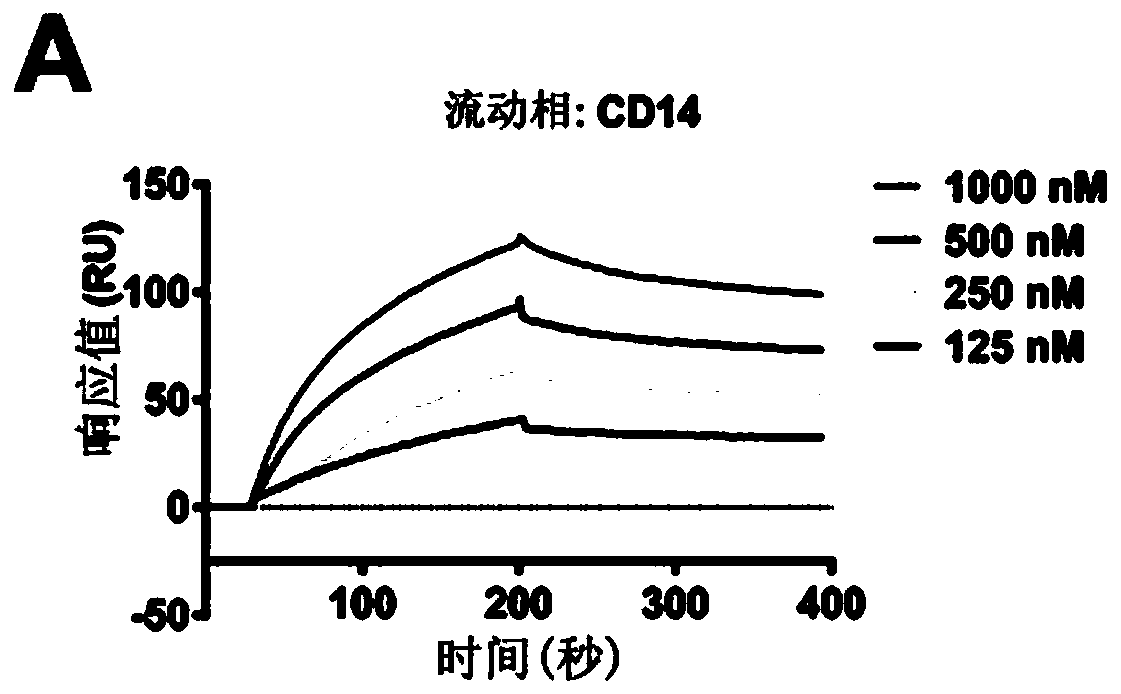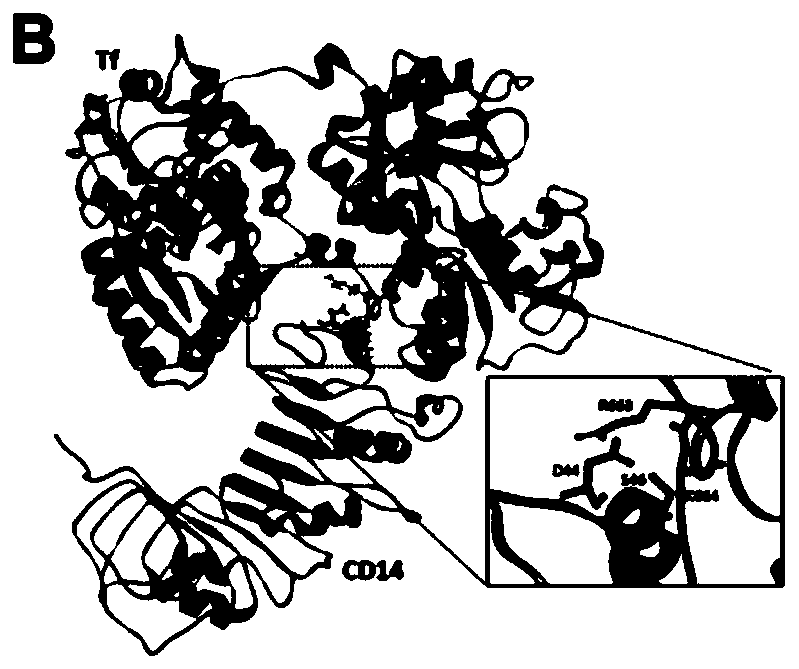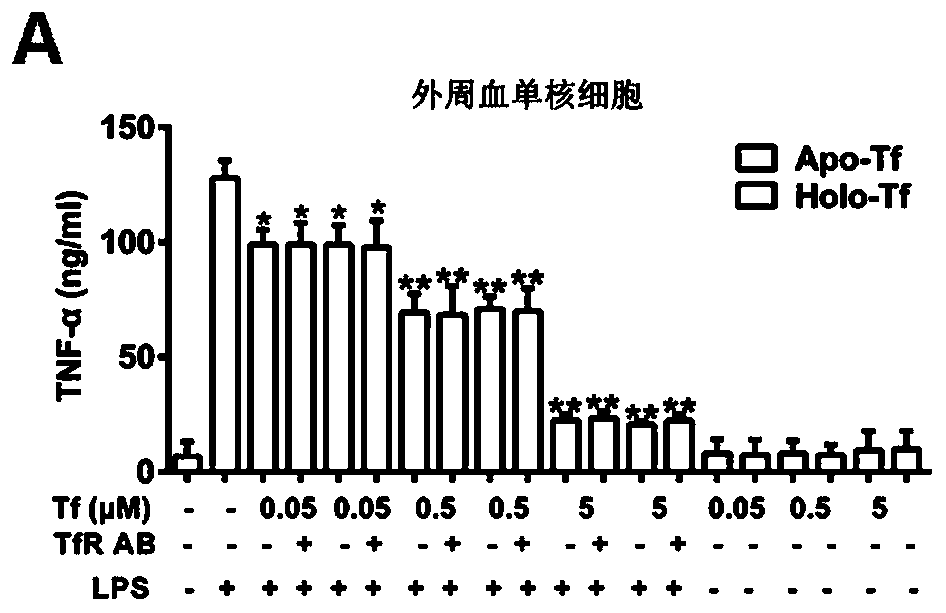Application of transferrin in preparing immunosuppressant medicines
An immunosuppressant, transferrin technology, applied in the field of biomedicine, can solve the problem of no transferrin activation, and achieve the effects of reducing liver tissue damage, reducing cell apoptosis, and inhibiting inflammatory responses
- Summary
- Abstract
- Description
- Claims
- Application Information
AI Technical Summary
Problems solved by technology
Method used
Image
Examples
Embodiment 1
[0041] Verification of transferrin immune target: BIAcore 2000 (GE, USA) was used to analyze the combination of transferrin and CD14.
[0042] Specific steps are as follows:
[0043] 1. Activate the CM5 chip (BR100012, GE, USA) with N-hydroxysuccinimide and 1-(3-dimethylaminopropyl)-3-ethylcarbodiimide hydrochloride activation solution, and then use A transferrin solution with a final concentration of 20 μg / ml diluted with sodium acetate solution (10 mM, pH=5) flows through the surface of the activated CM5 chip to covalently couple transferrin (500 reaction value), and the flow rate is 5 μl / ml. min.
[0044] 2. Use the same method and flow rate as step 1) to make 75 μl of blocking solution ethanolamine flow over the surface of the chip to block redundant sites.
[0045] 3. The mobile phase CD14 solution diluted with Tris buffer (20mM, pH 7.4) with different concentrations (125, 250, 500 and 1000nM) flows over the surface of the chip to detect the binding curve of transferrin...
Embodiment 2
[0048] Detection of the inhibitory effect of transferrin on inflammatory factors at the cellular level: detection of transferrin on LPS-induced cellular inflammatory factors.
[0049] The specific operation is as follows:
[0050]Peripheral blood mononuclear cells, neutrophils, dendritic cells derived from mouse bone marrow, mononuclear macrophages and venous endothelial cells were plated on 96-well plates. Then add different concentrations (0.05, 0.5, and 5 μM) of apo-transferrin (apo-transferrin) and holo-transferrin (holo-transferrin) to incubate with the above cells for 10 min, and finally add lipopolysaccharide (LPS, 2 μg / ml ) induced cell inflammation for 8h. Finally, the purchased Elisa kit was used to detect the contents of TNF-α, IL-6, IFN-β and TGF-β in the cell supernatant. The results are: transferrin can significantly inhibit the production of LPS-induced inflammatory cytokines ( Figure 2-A Indicates that transferrin inhibits the production of inflammatory fac...
Embodiment 3
[0052] Detection of the inhibitory effect of transferrin on inflammation in animals: overexpression of transferrin (PLP-Tf), knockdown (RNR-Tf) and tail vein injection of transferrin on the plasma inflammatory factors induced by lipopolysaccharide LPS, liver Effects of tissue damage.
[0053] First construct mouse transferrin overexpression (PLP-Tf) and knockdown (RNR-Tf) lentivirus and retroviral vectors and infect mouse models, the specific operation is: synthetic mouse transferrin coding region gene (GenBank: BC092046.1) and cloned into the pLVX-Puro (Clontech, USA) lentiviral overexpression vector. Design and synthesis of transferrin knockdown interference RNA (shRNA, nucleotide sequence shown in SEQ ID NO.1, specifically: 5'-AAGAATCTGAAGCAGGAAGACTTCAAGAGAGTCTTCCTGCTTCAGA TTCTTCTTTTTT-3'(forward oligo),) sequence and cloned into RNAi- ReadypSIREN-RetroQ (Clontech, USA) retroviral knockdown vector. The transferrin overexpression plasmid together with the viral packaging p...
PUM
 Login to View More
Login to View More Abstract
Description
Claims
Application Information
 Login to View More
Login to View More - R&D
- Intellectual Property
- Life Sciences
- Materials
- Tech Scout
- Unparalleled Data Quality
- Higher Quality Content
- 60% Fewer Hallucinations
Browse by: Latest US Patents, China's latest patents, Technical Efficacy Thesaurus, Application Domain, Technology Topic, Popular Technical Reports.
© 2025 PatSnap. All rights reserved.Legal|Privacy policy|Modern Slavery Act Transparency Statement|Sitemap|About US| Contact US: help@patsnap.com



